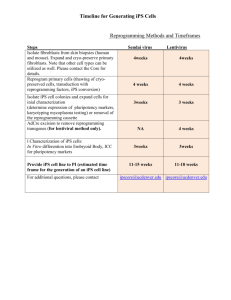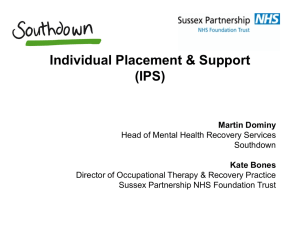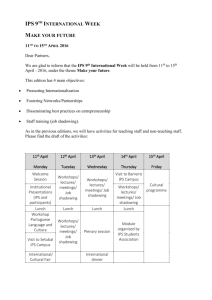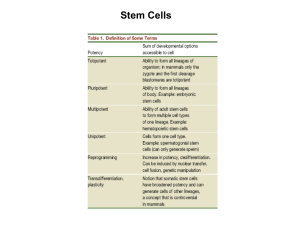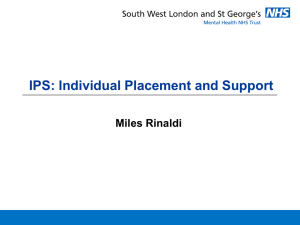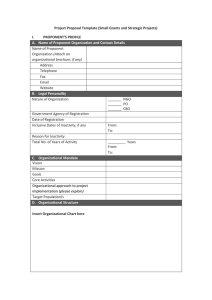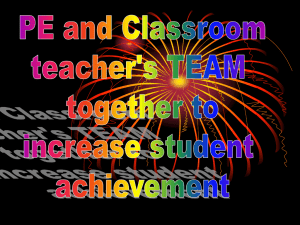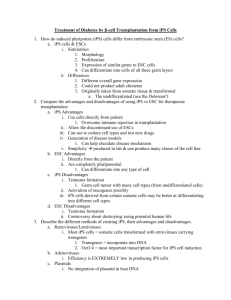Interface Management: An Emerging Discipline
advertisement
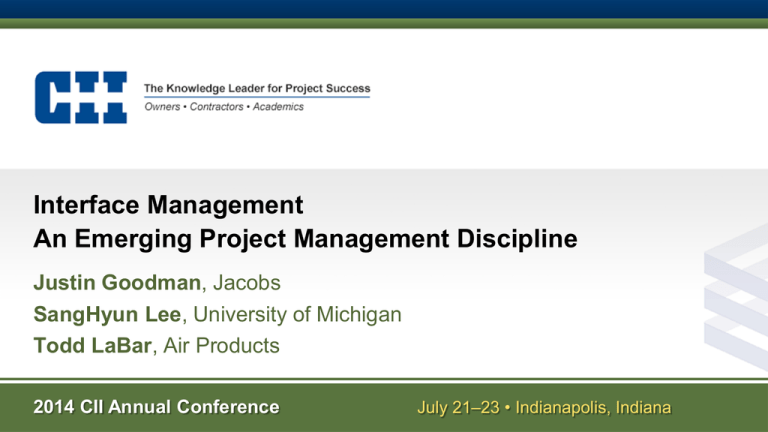
Interface Management An Emerging Project Management Discipline Justin Goodman, Jacobs SangHyun Lee, University of Michigan Todd LaBar, Air Products 2014 CII Annual Conference July 21–23 • Indianapolis, Indiana Research Team 302 ‒ Interface Management Seungjun Ahn, U of Michigan (new Ph.D.) Alexandre Rocha Do Nascimento, Petrobras Paul Burroughs, Ontario Power Generation Marty Reibold, URS Corp. Matt Cage, Alstom Power Samin Shokri, U of Waterloo (new Ph.D.) Justin Goodman, Jacobs Chris Smith, Architect of the Capitol Carl Haas, U of Waterloo Tim Swenk, McDermott International Jeff Hocke, Lauren Engineers & Constructors James Thorne, WorleyParsons Brian Johnson, Wood Group Mustang Paul Tompkins, Coreworx Inc. Todd LaBar**, Air Products Paul Van Der Merwe, Tenova Bateman SA SangHyun Lee, U of Michigan Lynn Neil Wheatcraft*, Dresser-Rand Debora Mello Ferreira, Petrobras Menzies Wilson, Smithsonian Institution * Chair ** Vice Chair Learning Objectives • Learning about Interface Management (IM) – What is Interface Management? – Why IM? – What level of IM is appropriate for a project or organization? • Understanding research findings • Introducing available IM products and tools What is “Interface Management” • An idea? • An industry norm? • A set of standards and practices? Have you heard of Interface Management or its practice? 0% No 0% Ye s A. Yes B. No Does your knowledge of IM align with that of your clients, partners, contractors, and/or competitors? 0% No tS ur e 0% No 0% Ye s A. Yes B. No C. Not Sure Does your company employ formal Interface Management practices and procedures? 0% No tS ur e 0% No 0% Ye s A. Yes B. No C. Not Sure What is “Interface Management” “Interface Management is the management of communications, relationships, and deliverables among two or more interface stakeholders” CII Research Team 302, 2014 Types of Interfaces • Soft Interface: Exchange of information between delivery teams or between delivery team and external party or language and cultural aspects. Interface Point at Flanged Joint Interface Stakeholder B • Hard Interface: Physical relationship between two or more components or systems. Interface Stakeholder A Interface Management Hierarchy Owner Contract Scope Insurance Certs FEED Doc Reporting MOMs, Daily Reports, Transmittals Contractor Battery Limit Payment Physical Boundary Utility Tie-Ins Location Data Network of Interface Stakeholders Interface Stakeholders Interface Points (IPs) Thickness of edges is associated with number of IPs between interface stakeholders. What is “Interface Management” “Interface Management is the management of communications, relationships, and deliverables among two or more interface stakeholders” CII Research Team 302, 2014 Why Interface Management? “What has happened in the industry to necessitate IM?” Why IM? • Dimensions of Complexity – Geographic spread of execution centers Level of Complexity High – Level of advanced technologies – Numbers of stakeholders or project participants Medium – Project delivery methods – Fast-tracked projects • Risk Management – Each interface represents a potential risk Low Do your projects mostly involve a simple relationship between two parties, OR multiple parties with varying levels of interest/impact on project outcome? 0% A. Simple B. Not Simple A. 0% B. Do you expect level of complexity on your projects to increase or decrease over next 10 years? A. Increase B. Decrease C. Stay the Same 0% A. 0% B. 0% C. Less or Least Complex – Project Team Co-located A Little More Complex – Same Team, Different Offices Three Interface Stakeholders Three Communication Channels : Fragmented information communicated via telecommunication (phone, email, etc.) More Complex – Add One More Stakeholder Four Interface Stakeholders Six Communication Channels Even More Complex – Add Two More Stakeholders Six Interface Stakeholders 15 Communication Channels, Multiple Interface Points per Channel What If…? Structural Engineer Owner Electrical Engineer Lead Engineer Mechanical Engineer 15 Communication Channels Increasing Complexity Due to Compressed Schedule FEP Design Linear Project Schedule Construction Commissioning & Startup (C&S) FEP Design Construction C&S Compressed Project Schedule Operation Operation Have multiple locations, languages, or cultural differences affected complexity of your projects? 0% A. Yes B. No A. 0% B. On average, how many execution locations are involved in your projects? A. Less than 5 B. 5 - 10 C. More than 10 Local Project Execution Darlington Nuclear Generating Station four-units /net output of 3,512 megawatts (MW) Ontario Hydro – Owner (Toronto) Ontario Hydro (Construction) Atomic Energy of Canada – Reactor Design (Mississauga) Ontario Hydro – Design/Engineering Management (Toronto) 25 ABB - Turbine/Generator Supply (Scarborough) Globally Dispersed Project Execution Construction Site Engineering (ingénierie) Module Fabrication (모듈 조립) Engineering Fabrication (fabricação) (अभिय ांत्रिकी) : Fragmented information communicated via telecommunication (phone, email, etc.) 26 What complexity factor most warrants FORMAL IM practices? A. B. C. D. E. Multiple geographic locations New or advanced technologies Multiple owners, contractors, and/or sub-contractors New geographic location Fast track schedule 0% A. 0% 0% B. C. 0% 0% D. E. Which of these is the best means to communicate critical interface information with another stakeholder? A. Fax B. Phone call C. Meeting where both took notes 0% 0% 0% B. C. 0% 0% D. E. D. Email exchange A. E. Written agreement in standard form Complexity Curve Formal Interface Management • Interface Management Personnel • IM Procedures & Practices • Standardized Interface Agreement Forms • IM Specific Software IM – An Emerging Project Management Discipline Project Management: 1950s Project Controls: 1960s Quality Management: 1970s Risk Management: 1980s IM: 2000s Research Methodology Literature Review Focus Group Questionnaire Development Pilot Survey Structured Interview Data Analysis Tools & Guide • Literature Review – Previous CII reports, Interface Management in construction & other disciplines. • Structured Interview (facilitated with Survey Questionnaire) – Use of face-to-face or phone interviews – Total 46 Projects (representing over $150 Billion in CAPEX) IM Formality and Project Size Formal IM Informal IM 12 10 # of Projects 10 8 8 8 6 6 4 5 3 2 3 1 1 0 <$500M $500-$1B $1B-$5B $5B-$10B >$10B Project Dollar Value Formal IM more prevalent in projects of higher $ value IM Formality and Project Delivery Strategy Formal IM Informal IM 25 21 # of Projects 20 18 15 10 10 5 5 3 4 9 5 4 3 0 DBB DB EPCM EPC Others Project Delivery Strategies EPC & EPCM most common delivery strategies with Formal IM IM Formality among Interface Stakeholders Informal IM Formal IM 16 14 # of Projects 14 12 10 10 8 7 7 6 6 4 2 2 0 1-5 5-15 >15 # of Interface Stakeholders IM is more prevalent on projects with more stakeholders Project Characteristics Correlation with IM Implementation Project Size # Interface Stakeholders (0.33) # JVs/Owners (0.24) # Locations (0.14) Correlation (0.56) IM Implementation vs. Project Phase Sequential Project Phasing 12 % Feasibility Concept Detailed Scope 88 % Feasibility Concept Detailed Scope Design Commissioning & Start-up Construction Operation Design Construction Commissioning & Start-up Operation Parallel Project Phasing Start IM at Concept and Detailed Scope Phase IM Implementation vs. Project Cost Growth Formal IM Projects Had Lower Mean of Cost Growth & Less Standard Deviation sdfsdf Cost Growth p=0.25 Mean: 0.18 Standard Deviation: 0.38 Informal IM (n=27) Mean: 0.04 Standard Deviation: 0.16 Formal IM (n=10) Globally Dispersed Project Execution Ingénierie Construction Site Fabricação (Fabrication) 39 (Engineering) 모듈 조립 (Module Fabrication) अभिय ांत्रिकी (Engineering) Formal Interface Management • Interface Management Personnel • IM Procedures & Practices • Standardized Interface Agreement Forms • IM Specific Software Tools Developed by RT 302 • Interface Management Implementation Guide (IMIGe) – Project Interface Risk-Impact (PIRI) Matrix – Interface Complexity Assessment Tool (ICAT) – IM Maturity Tool – IM Implementation Roadmap PIRI Matrix Project Interface Risk-Impact Matrix ICAT* * Interactive Spreadsheet Interface Management Implementation Guide (IMIGe) IMIGe Interface Point at Flanged Joint Interface Stakeholder B Interface Stakeholder A Feasibility Establish pro ject viability Concept (Pr e-F Develop projec t organization EED) Detailed Sc oping (FEED) Detailed Design/Eng ineering Procurement Constructio Commission n ing and Identify top Start-up stakeholders Continue sta keholder identification Develop WB S Develop IM stra teg the project (M y for Begin implementing IP) IM Update and strategy assess IM Up Align / establ date and ass ish soft strategy and ess IM Condu Align / establ MIP interface rela ct formal strategy and ish soft tionships MIP Implement spe interface rela lessons learne cific IM Measu tionships d re IM procedures Identify top-lev Benchmark IM el IPs per for ma nce Identify hard between WB Evaluate IM performance IP's S packages Continue ide performance ntifying Co ntinue identif hard and sof ying Contin t IPs ue identifying hard and sof t IPs hard and sof t IPs Develop the IA Sta rt executing IAs scheme for Execute hard and sof IAs for hard t IPs Close out IAs and soft IP's for hard and soft IPs Summary of Tools Developed by RT 302 • Interface Management Implementation Guide (IMIGe) – Project Interface Risk-Impact (PIRI) Matrix – Interface Complexity Assessment Tool (ICAT) – IM Maturity Tool – IM Implementation Roadmap Learning Objectives • Learning about Interface Management (IM) – What is Interface Management? – Why IM? – What level of IM is appropriate for a project or organization? • Understanding research findings • Introducing available IM products and tools What’s in It for Me? • Industry established and recognized common language • Clearer understanding of level of IM required • Better IM likely relates to better project cost performance • Earlier recognition of risks to facilitate mitigation • Effective products and tools for immediate use Wrapping Up • RT 302’s exciting research on IM is only “the beginning” • More complex projects require more formal IM • Cost growth likely improves with formal IM • All of our tools are now available from CII as your guide to IM National Museum of African American History and Culture Panel Discussion Panel Experts for Audience Q&A • Carl Haas – University of Waterloo • Todd LaBar – Air Products (RT 302 Vice Chair) • SangHyun Lee – University of Michigan • Lynn Wheatcraft – Dresser-Rand (RT 302 Chair) • Menzies Wilson – Smithsonian Institution
